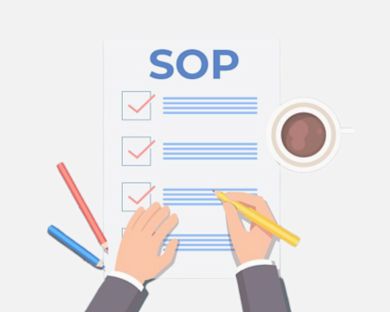Topics covered
- 10 min
- Published: 17 April 2024
- Updated: 16 April 2024
Unlock your potential in biotechnology by studying at a top university in the US
There are many compelling reasons to study in the US. First, the country is home to some of the world's most prestigious and respected universities, with a long-standing tradition of academic excellence. Students in the US can choose from a diverse range of programs across multiple disciplines and fields, from business and technology to the arts and humanities.
Biotechnology has emerged as a versatile solution to meet a wide range of human needs. Its applications include reducing CO2 emissions, improving medical diagnosis through genetically engineered tobacco plants, creating sustainable agriculture techniques, and pre-treating industrial and food waste through bioremediation. With such diverse application possibilities, study, and research in the field of Biotechnology are evolving rapidly and are becoming one of the most important technology areas of the time.
Studying biotechnology in the US can offer an excellent opportunity for students interested in pursuing a career in this rapidly growing field. The country is home to many leading universities and research institutions that offer top-notch programs in biotechnology, with a focus on cutting-edge research and practical applications.
In this blog, we will explore study and work opportunities in the field of Biotechnology in the US.
What is Biotechnology?
Biotechnology is the combination of Bio i.e., Life and Technology i.e., the application of scientific knowledge to improve the life. Although it was the Age of Renaissance that saw the beginning of technological advancements in terms of modern-day inventions, innovations and discoveries, mankind had been practicing biotechnology since 6000 BC in the form of making cheese, yoghurt, bread, and wine.
It was in the 20th century when Biotechnology brought industry and agriculture together. The discovery of microorganisms, pasteurisation, and penicillin along with the study of genetics using seeds and plant experiments were some of the crucial developments in expanding the horizon of Biotechnology. The discovery of DNA structure that led to the Human Genome Project in 1985 gave the final threshold to the field.
Biotechnology has also enabled the printing of human organs in space and the unlocking of the potential of marine bio-resources. With these diverse applications, biotechnology has transformed science fiction into reality and promises to meet the needs of human life on land, water, and in space.
Join the IDP student community
Connect with peers and student ambassadors to hear real experiences, tips, and advice about studying abroad.

Why study Biotechnology in the US?
There are many countries in the world that have programs in biotechnology, and the best country for you to do the same will depend on individual factors. Some factors to consider when choosing a country to study biotechnology include the quality of the program, the research opportunities available, the job market, and the overall cost of attendance (tuition and living).
Studying biotechnology in the US offers access to world-class research facilities and resources, including state-of-the-art laboratories and cutting-edge equipment. This provides students with the opportunity to conduct research and gain practical experience in a range of areas, from drug development and bio-manufacturing to agriculture and environmental sustainability.
As per the Open Doors Report, around 200,000 Indian students opted for the US as their preferred destination for higher education during the 2021-22 academic year. This marks a 19% rise from the previous year's figure of 167,582.
Below are a few facts to help a student decide before embarking upon their journey to study Biotechnology in the US:
Quality of the Program: According to QS World University Rankings by Subject, 6 out of top 10 universities for Biotechnology programs in the world are in the US.
Research Opportunities: 9 out of 10 best research institutions in the world in the field of Biotechnology are in the US. Historically, the US, both in absolute dollar amounts and as a percentage of its research budget, has had the largest commitment to basic research in the biological sciences worldwide. Biotechnology funding by the NIH was around 7.85 billion USD during fiscal year 2021.
Job Market: The employment of biological technicians is projected to grow 9 percent from 2021 to 2031, faster than the average for all occupations. STEM-designated program offering 24 months extension. Traditionally, with an F-1 visa, you were eligible for up to 12 months of Optional Practical Training (OPT). STEM students are allowed to apply to extend that period even longer (up to 24 months).
Popular specialisations in Biotechnology
Biotechnology is a vast field that encompasses a wide range of specialisations, each with its own unique focus and application. Here are some of the popular specialisations in biotechnology that are currently in demand:
Biochemistry
Microbiology
Biophysics
Biostatistics
Bioinformatics
Biomedical
Forensic Science
Neuroscience
Regenerative Medicine
Marine Biotechnology
Food Biotechnology
Medical Biotechnology
Cellular and Molecular Biotechnology
Biotechnology Enterprise
Biodefense
Regenerative and Stem Cell Technologies
Regulatory Science
Agricultural Biotechnology
Admission and application process for MS in Biotechnology in US
If you're considering pursuing a Master of Science (MS) in Biotechnology in the US, it's important to familiarize yourself with the admission and application process. As a highly competitive and sought-after field, admission requirements and deadlines can vary across universities and programs. By understanding the key elements of the application process, you can ensure that you submit a strong and comprehensive application to increase your chances of being accepted into your desired program.
Eligibility criteria for MS in Biotechnology in the US
To apply for a masters degree in the US, most universities require:
A bachelor's degree and marksheets of all semesters (latest semester if pursuing)
16 years of education (a 4-year bachelor's degree in India), although some universities accept 3-year degrees
A degree in a relevant field is recommended, but universities may accept a degree from a distant background with relevant work experience, internships, or demonstrated interest in the field.
A minimum GPA of 3 out of 4, which can be calculated using a conversion scale from the student's original GPA score (1-10 or 1-100%)
Graduate transcripts
GRE scores (requirements and scores vary by university)
English language proficiency scores such as IELTS (scores vary by university)
An updated Résumé
Letters of Recommendation (LOR) (generally 3)
Work experience/internship documents
Some universities may require credential evaluation, which is mostly applicable to students
A valid passport
Cost, duration and documents for studying MS in biotech in the US
The tuition fee in the top universities for MS in Biotechnology in the US varies depending on the university, ranging from $40,000 to $90,000 (32 Lakhs INR to 72 Lakhs INR). Here arere the cost, duration, and documents required to study MS in Biotechnology in different universities in the US:
S. No | University name, campus | Course name | GPA/IELTS/GRE | Duration-credits | Approx. Tuition fees ($) |
1 | Florida Institute of Tech. | MS in Biotechnology | GPA: 3 / IELTS: 6 / GRE: Required | 2 Yrs. - 30 Credits | 42,500 |
2 | California State Univ. | MS in Biotechnology | GPA: 3 / IELTS: 6 / GRE: Required | 2 Yrs. - 38 Credits | 38,256 |
3 | Northeastern Univ. | MS in Biotechnology | GPA: 3 / IELTS: 6.5 / GRE: Not Required | 2 Yrs. - 34 Credits | 58,800 |
4 | Univ. of Alabama | MS in Biotechnology | GPA: 3 / IELTS: 6.5 / GRE: Not Required | 1 Year - 37 Credits | 55,352 |
5 | Univ. of Maryland | MS in Biotechnology | GPA: 3 / IELTS: 6.5 / GRE: Not Required | 1.5 Yrs. - 30 Credits | 54,198 |
6 | Colorado State Univ. | Masters of Biomanufacturing and Biotechnology | GPA: 3 / IELTS: 6.5 / GRE: Not Required | 2 Yrs. - 33 Credits | 45,000 |
7 | Univ. of Delaware | Professional Science Master’s (PSM) Degree in Biotechnology | GPA: 3 / IELTS: 6.5 / GRE: Required | 2 Yrs. - 42 Credits | 41,118 |
8 | Univ. of California | MS in Biotechnology | GPA: 3 / IELTS: 6.5 / GRE: Not Required | 2 Yrs. - 30 Credits | 33,769 |
9 | Purdue Univ. | Master of Science in Biotechnology Innovation & Regulatory Science | GPA: 3 / IELTS: 6.5 / GRE: Not Required | 1.5-2 Yrs. - 30 Credits | 30,900 |
10 | Univ. of Houstan | MS in Biotechnology | GPA: 3 / IELTS: 6.5 / GRE: 290 | 1.5 Yrs. - 30 Credits | 29,790 |
11 | Columbia Univ. | MA in Biotechnology | GPA: Not Specified / IELTS: 7 / GRE: Required | 30 Credits | 67,600 |
12 | John Hopkins Univ. | MS in Biotechnology | GPA: 3 / IELTS: 7 / GRE: Not Required | 1.5 Yrs. - 30 Credits | 52,080 |
13 | Univ. of Wisconsin | Master of Biotechnology | GPA: 3 / IELTS: 7 / GRE: Not Required | 1.5-2 Yrs. - 34 Credits | 42,000 |
14 | Indiana Univ. |
| GPA: 3 / IELTS: 7 / GRE: Not Required | 1.5 Yrs. - 30 Credits | 37,678 |
15 | Northwestern University | Master of Biotechnology | GPA: 3.5 / IELTS: 7.5 / GRE: Not Required | 21 Credits | 86,495 |
16 | University of Pennsylvania | MS in Biotechnology | GPA: NA / IELTS: 7.5 / GRE: Optional | 11 Credits | 63,000 |
Duration of a master’s in biotechnology Program varies from 1 Year to 2 Years depending on the credit requirement of the program. MS in Biotechnology programs with research inclination are usually longer than Professional master’s program.
Application process and timeline for MS biotechnology in the US : Spring Intake
The application window for MS biotechnology in US opens three times a year for summer, fall and winter semesters. A few of them also accepts application on a rolling basis i.e., colleges review applications as they're sent in; there is no hard deadline by which you need to submit your application.
Below is the basic timeline with the application steps for the Spring intake:
STEPS | Action Points | Month |
|---|---|---|
Step 1 | Shortlist the Universities. | January |
Step 2 | Prepare for Tests (GRE + IELTS) Prepare Statement of Purpose (SOP) Get college transcripts and related documents, Letters of Recommendation (LOR) from the university | Feb-March |
Step 3 | Get Test Scores (GRE + IELTS) | March-April |
Step 4 | Apply to the universities. | April- May |
Step 5 | Apply for I-20 after receiving offer letter. | July-Aug |
Step 6 | Fill DS 160 form once I-20 received. Save DS-160 Confirmation page for VISA interview. Create profile on US Travel Docs. Pay $160 VISA Application Fees. Book the slot. Give Bio-metric (OFC Appointment) followed by VISA interview. | Sept-Oct |
Step 7 | After VISA approval you can fly to your university (You can enter in US not before 30 days of your program commencement) | Nov-Dec |
Application process and timeline for MS biotechnology in the US : Fall Intake
Below is the tentative timeline with the application steps for Fall intake:
STEPS | Action Points | Month |
|---|---|---|
Step 1 | Shortlist the Universities. | March-April |
Step 2 | Prepare for Tests (GRE + IELTS) Prepare Statement of Purpose Get college transcripts and related documents, Letters of Recommendation from the university | May-June |
Step 3 | Get Test Scores (GRE + IELTS) | July-Aug |
Step 4 | Apply to the universities. | Sept - Dec |
Step 5 | Apply for I-20 after receiving offer letter. | Jan - March |
Step 6 | Fill DS 160 form once I-20 received. Save DS-160 Confirmation page for VISA interview. Create profile on US Travel Docs. Pay $160 VISA Application Fees. Book the slot. Give Bio-metric (OFC Appointment) followed by VISA interview. | April - June |
Step 7 | After VISA approval you can fly to your university (You can enter in USA not before 30 days of your program commencement) | July-Aug |
Application process and timeline for MS biotechnology in the US – Summer Intake
Summer intake classes typically commence between May and June, and many universities offering this option set their application deadlines between January and March. It is advisable for international students to submit their applications as early as possible to ensure a seamless visa process by April. Notable universities that offer summer intake include John Hopkins University, University of Houston-Clear Lake, the University of Alabama at Birmingham, and the University of South Florida.
Scholarships for MS in biotech courses in the US
The different ways a student can fund their education are through scholarships, fellowships, assistantships, and interest-free loans for doing post-graduate and PhD degree courses.
The following list comprises scholarships and fellowships available to Indian students and researchers who are pursuing higher-level studies, mainly in the field of science, with a particular emphasis on biotech or advanced life science branches:
The International Peace Scholarship
BeArt Presets-Academic Scholarship
Central Sector Scheme of National Overseas Scholarship by Govt. of India
Debesh Kamal Scholarship
JN Tata Endowment Scholarship
Robert S. McNamara Fellowship Program
M.M. Arunachalam–Lakshmi Achi Overseas Loan Scholarship
Aga Khan Foundation International Fellowship Program
Bharat Petroleum - Scholarship for higher studies
Ministry of Human Resource Development International Scholarships
Assistantships for MS in Biotech in the US
Universities also provide different types of Assistantships to the students to help them manage the finances. It’s an arrangement in which financial support is given to a graduate student who engages in teaching and/or research in furtherance of the university’s academic mission, as well as his or her graduate education.
These are Teaching Assistant (TA), Research Assistant (RA), Graduate Assistant (GA), and Graduate Research Assistant (GRA). These awards are administered to specific college departments. There is no separate application for assistantships. The assignment is usually in your major field or a closely related one.
Teaching Assistants (TAs): A teaching assistant is an academic appointment in support of the teaching of a course. Teaching assistants may assist in teaching a section of a course, lead discussions, and/or lead laboratory sections. Teaching assistants average no more than 15 hours per week for the base stipend as established by the University officials.
Assistantships (GRAs): A GRA is an academic appointment focused on thesis or other degree-related research of a type that is required from all candidates for the degree. The research project for a GRA directly supports the student’s thesis or dissertation. Because a student devotes considerable time to thesis or dissertation research, the time spent relates to the project.
Research Assistantships (RAs): A RA is an academic appointment for research that is not directly thesis-related, 15 to 20 hours per week, averaging no more than 15 hours per week. For example, a RA appointment might include data analysis on a faculty research project not directly related to the student’s dissertation topic. As with other assistantships, there is no separate application. Students are appointed by departments, fields, or individual faculty.
Graduate Assistantships (GAs): A GA is an academic appointment requiring 15 to 20 hours a week, averaging no more than 15 hours per week, for the base stipend as established by the University officials. For example, a GA appointment might include assisting a faculty member in developing and coordinating an academic conference.
Top Universities for MS in Biotechnology in the US
These are the top 15 universities for programs related to Biological Sciences according to the QS World University Rankings by Subject 2023: Biological Sciences
S. No | University Name |
1. | Harvard University |
2. | Massachusetts Institute of Technology (MIT) |
3. | Stanford University |
4. | University of California, Berkeley (UCB) |
5. | University of California, San Diego (UCSD) |
6. | Yale University |
7. | University of California, Los Angeles (UCLA) |
8. | University of California, San Francisco |
9. | Cornell University |
10. | Johns Hopkins University |
11. | California Institute of Technology (Caltech) |
12. | Columbia University |
13. | University of Pennsylvania |
14. | University of Chicago |
15. | Princeton University |
These universities offer a wide range of programs in Biotechnology. They also have exceptional faculty, research facilities, industrial connections and resources to support students in their studies and career aspirations. However, it's important to note that admission to these universities can be highly competitive and require strong academic credentials. It's important to research each program carefully and ensure that it aligns with your goals and interests.
Scope and employment prospects after the Biotechnology course in the US
Biotechnology as a field has expanded its gamut to almost all spheres of human interactions.
In the report "Fostering Innovation and Driving America's Economy Forward" by the Biotechnology Innovation Organization (BIO) and the Council of State Bioscience Associations (CSBA), it is stated that the bioscience industry in the US has experienced significant growth in investment and employment. Specifically, between 2018 and 2022, the number of employees in the industry increased by 11%, resulting in an economic impact of almost $3 trillion. Here are some key takeaways of the report:
The nation’s bioscience industry employed 2.1 million employees across more than 127,000 U.S. business establishments in 2021
As the overall economy shed 1.5% of its job base, the biosciences industry increased employment by 11% since 2018
In total, the bioscience industry’s economic impact on the U.S. economy amounted to $2.9 trillion dollars in 2021, as measured by overall output
Biotech companies – especially small – and mid-sized – undertook a monumental effort to develop COVID-19 vaccines and therapeutics; there are 747 novel compounds in development currently
BIO is the world’s largest trade association representing biotechnology companies, academic institutions, state biotechnology centres and related organizations across the US and in more than 30 other nations.
*Source: https://www.bio.org/
Average salary after MS in Biotechnology
Average salary may vary with the location, position, skill set, degree, etc. but here’s the basic that you can earn after studying MS in biotechnology:
*According to PayScale data, as on April 06, 2023
Pay-by-experience level for Biotechnology professionals in the US
An entry-level Biotechnologist with less than 1 year experience can expect to earn an average total compensation of $49,428. An early career Biotechnologist with 1-4 years of experience earns an average total compensation of $53,586. A mid-career Biotechnologist with 5-9 years of experience earns an average total compensation of $74,152. An experienced Biotechnologist with 10-19 years of experience earns an average total compensation of $70,000.
*According to PayScale data as on April 06, 2023
Biotechnologist related job salaries | Avg. salary |
Research Scientist | $55k — $125k |
Research Scientist, Biotechnology | $62k — $125k |
Research Associate, Biotechnology | $47k — $82k |
Senior Research Scientist, Biotechnology | $80k — $145k |
Senior Mechanical Engineer | $82k — $138k |
Chemist | $45k — $88k |
Design Engineer | $56k — $104k |
Product Engineer | $60k — $102k |
Research Associate (Unspecified Type) | $41k — $81k |
*According to PayScale data, as on April 06, 2023
Biotechnology is about making discoveries that make the world a better place, and about bringing those concepts to life and into the market. Spanning industries, including pharmaceuticals, agriculture, healthcare, marine ecosystem, environment, energy, national security, space explorations biotechnology covers roles from the R&D lab, product development, and manufacturing to sales, marketing, finance, and law. With a wide range of course specialisations and electives, students can design their degree as per their future aspirations and career goals.
As the demand for biotech specialists expands throughout the market & BLS projects employment growth of 9% from 2021 to 2031, making the field grow faster than the average for all occupations, getting an MS degree in Biotechnology from US can guarantee a resilient and rewarding career with a plethora of opportunities.
If you want to study a biotechnology course in the US, get in touch with our international education expert at IDP for end-to-end admission guidance.
One account for all your study abroad needs
Create your profile and unlock a wide array of features including personalised recommendations, fast-tracked applications and much more.











